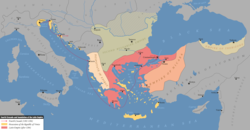Draft:Georgian expedition to Chaldia
 | Review waiting, please be patient.
This may take 2–3 weeks or more, since drafts are reviewed in no specific order. There are 699 pending submissions waiting for review.
Where to get help
How to improve a draft
You can also browse Wikipedia:Featured articles and Wikipedia:Good articles to find examples of Wikipedia's best writing on topics similar to your proposed article. Improving your odds of a speedy review To improve your odds of a faster review, tag your draft with relevant WikiProject tags using the button below. This will let reviewers know a new draft has been submitted in their area of interest. For instance, if you wrote about a female astronomer, you would want to add the Biography, Astronomy, and Women scientists tags. Editor resources
Reviewer tools
|
This article includes a list of general references, but it lacks sufficient corresponding inline citations. (July 2025) |
| Georgian expedition to Chaldia | |||||||
|---|---|---|---|---|---|---|---|
| Part of Byzantine-Georgian wars | |||||||
 Kingdom of Georgia during its Golden Age. | |||||||
| |||||||
| Belligerents | |||||||
|
| Byzantine Empire | ||||||
| Commanders and leaders | |||||||
|
Tamar the Great Alexios I Komnenos David Komnenos | Unknown | ||||||
The Georgian expedition to Chaldia (Georgian საქართველოს ლაშქრობა ხალდიაში) refers to a military campaign led by the Kingdom of Georgia against the Byzantine Empire, specifically targeting the region of Chaldia (also spelled Khaldia), a province on the southeastern coast of the Black Sea, centered around Trebizond (modern Trabzon, Turkey).
Background
[edit]

Despite the territorial losses to Basil II, the Georgian kings succeeded in retaining their independence and in uniting most of the Georgian lands into a single state. Many of the territories ceded to the empire were conquered by the Seljuk Turks towards the 1070s-1080s, securing the theme of Iberia by the help of Byzantine governor, Gregory Pakourianos, who began to evacuate the region shortly after the disaster inflicted by the Seljuks on the Byzantine army at Manzikert. On this occasion, George II of Georgia was bestowed with the Byzantine title of Caesar, granted the fortress of Kars and put in charge of the Imperial Eastern limits.
Relations between the two Christian monarchies were then generally peaceful except for the episode of 1204, when Emperor Alexios III Angelos seized a sizable donation of the then Georgian regent Queen Tamar, that was meant for the monks of Mount Athos. Infuriated by this action, Tamar used this hostile act as a pretext for her expansion along the southwestern coast of the Black Sea, populated by a large Georgian-speaking population.
Tamar's ambitions were aided by the ongoing Fourth Crusade, which eventually fractured the Byzantine Empire.
Foundation Trebizond empire
[edit]
A Georgian army under the command of Alexios and David Komnenos attacked the Byzantines from the east in late March or early April 1204. According to Georgian chronicles the expedition took eight days, it reached Trebizond via Lazona and seized Trebizond in April. The local commander doux Nikephoros Palaiologos, did not put up an effective defence against the Georgian forces.
On April 13, 1204, Constantinople fell to the Crusaders, where they established the Latin Empire. According to medieval sources, newly incorporated territories were given to Alexios and David Komnenos, where they founded a pro-Georgian state, the Empire of Trebizond. Alexios was proclaimed emperor, while David was appointed strategos. Some scholars believe that the new state was subject to Georgia, at least in the first years of its existence, at the beginning of the 13th century.
The following year, David Komnenos commanded the Georgian troops in a successful campaign that resulted in the conquest of territories between Trebizond and Heraclea Pontica, while Alexios defeated the Seljuks and recaptured Amisos, Sinope, Oinaion and Chalybia.
Tamar's political involvement in the Fourth Crusade, her exploitation of the Byzantine decline, and military campaigns, decisively expanded the Kingdom of Georgia's influence and number of tributaries, turning her kingdom into one of the most powerful Christian states at the time.
References
[edit][1] [2][3] Holmes, Catherine (2005), Basil II and the Governance of Empire</ref>(976–1025), p. 482. Oxford University Press, ISBN 0-19-927968-3.
Alemany, Agusti (2000). Sources of the Alans: A Critical Compilation, p. 222. Brill Publishers, ISBN 90-04-11442-4. Robert Bedrosian, "Liparit IV Orbēlean", p. 586. In: Joseph Reese Strayer (1983), Dictionary of the Middle Ages. Scribner, ISBN 0-684-16760-3. Paul A. Blaum (2005). Diplomacy gone to seed: a history of Byzantine foreign relations, A.D. 1047-57. International Journal of Kurdish Studies. (Online version) Archived 2008-04-30 at the Wayback Machine
- ^ Mikaberidze, A. (2015). Historical dictionary of Georgia. 2nd ed. Lanham, MD, United States: ROWMAN & LITTLEFIELD, p.634.
- ^ Vasiliev, A.A., “The Foundation of the Empire of Trebizond 1204-1222”, Speculum 11 (1936), pp. 3-37·
- ^ Vasiliev, A.A., “The Foundation of the Empire of Trebizond 1204-1222”, Speculum 11 (1936), pp. 3-37·
